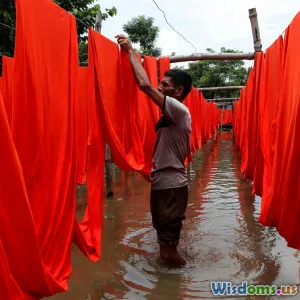
How Fast Fashion is Quietly Damaging Local Water Supplies
7 min read Explore how fast fashion's massive water usage and pollution threaten local water supplies globally. (0 Reviews)
How Fast Fashion is Quietly Damaging Local Water Supplies
Fast fashion has revolutionized the way we consume clothing, offering trendy garments at lightning speed and low prices. However, beneath the glossy storefronts and viral social media posts, a darker environmental narrative is unfolding—one that few people fully appreciate. Local water supplies around the world are bearing the brunt of fast fashion's vast water usage and industrial pollution. This silent but severe crisis threatens ecosystems, human health, and the social fabric of many communities.
The Water-Hungry Reality of Fast Fashion
The production of fast fashion’s cheap and rapidly changing clothing collections requires enormous volumes of water. According to the World Wildlife Fund (WWF), producing a single cotton t-shirt consumes approximately 2,700 liters of water—enough water for one person to drink for 2.5 years. When multiplied by the billions of garments manufactured annually, this demand translates into staggering pressure on freshwater resources.
Cotton, the most common fabric in fast fashion, is notorious for its heavy water footprint. Major textile hubs like India, Pakistan, and Uzbekistan often face water scarcity issues compounded by intensive cotton farming. For instance, in the Amu Darya basin, cotton over-irrigation has been a major factor in the desiccation of the Aral Sea, a once-vibrant body of water now shrunken to fractions of its former size.
Toxic Pollutants Flowing Into Waterways
Beyond the vast quantity of water used, the quality of water discharged from textile production is an equally pressing concern. Fast fashion relies heavily on chemical-intensive processes—dyeing, bleaching, and finishing—that release toxic effluents rich with dyes, heavy metals, detergents, and other pollutants into local rivers and groundwater.
In the industrial regions of Bangladesh, one of the world’s leading apparel exporters, reports indicate that textile factories discharge untreated or only partially treated wastewater directly into the Buriganga River. This contamination contains dangerous substances such as lead, cadmium, chromium, and azo dyes, which are linked to severe health problems including cancers and organ damage.
Scientists estimate that textile dyeing operations are among the top polluters of clean water worldwide, responsible for around 20% of global industrial water pollution. Communities living downstream suffer from high rates of skin ailments, gastrointestinal diseases, and poisoned drinking water.
Impact on Local Communities
The consequences of fast fashion’s water footprint extend far beyond ecological damage. Local communities often bear the social and economic costs.
In Cambodia’s textile manufacturing zones, residents have reported troubling changes: wells drying up and pollution spoiling surface water sources. Women fetching water for families increasingly find themselves using contaminated streams and rivers, leading to spikes in waterborne diseases. Additionally, fish populations collapse—the primary protein source for many households—further impacting food security.
Moreover, there is often little recourse or compensation for affected populations. Weak environmental regulations, lack of enforcement, and the prioritization of economic growth over sustainability allow factories to benefit while local resources degrade.
The Role of Global Supply Chains and Low Consumer Awareness
The environmental strain is amplified by the speed-focused, profit-driven business model of fast fashion. Brands push huge volumes of cheaply produced garments designed for short use cycles and rapid disposal—a practice that escalates demand for raw materials and processing.
Many global apparel brands outsource production to countries where environmental regulations are lax or poorly enforced, effectively shifting the pollution burden to vulnerable regions. This disconnect leaves consumers detached from the environmental consequences of their purchases.
Studies show that up to 35% of consumers are unaware of the water pollution issues linked to clothing manufacture. Without this knowledge, behavioral shifts like choosing sustainably made apparel or supporting regulation reforms remain limited.
Positive Steps Towards Mitigation
Fortunately, there are encouraging initiatives and technologies aiming to address this crisis:
-
Innovative Textile Recycling: Some startups are developing processes to recycle fibers and reduce virgin cotton demand, decreasing water use.
-
Waterless Dyeing Technologies: Companies such as ColorZen and DyeCoo utilize cutting-edge dyeing methods that drastically minimize water consumption and hazardous runoff.
-
Legislative Actions: Countries like China are strengthening wastewater standards for textile factories, and international bodies push for environmental compliance along supply chains.
-
Consumer Awareness Campaigns: NGOs and transparency platforms help educate consumers about harmful impacts and promote ethical brands.
The combined efforts of industry reform, consumer responsibility, and governmental oversight represent a holistic strategy to safeguard water resources.
Conclusion: From Awareness to Action
Fast fashion’s affinity for quick turnover and low costs hides deep environmental damage, especially to local water supplies. The consequences ripple through ecosystems and the lives of millions, often unnoticed amid the globalized web of production and consumption.
Reducing fast fashion’s water footprint requires collective responsibility—from designers and manufacturers rethinking processes, governments enforcing stronger regulations, retailers committing to transparency, and consumers making more informed, sustainable choices.
As awareness grows, so does the opportunity to disrupt the cycle of water pollution and scarcity fueled by fashion’s fast lane. By peeling back the layers of convenience, the true cost of our clothing becomes clear—and with it, a path toward more sustainable stewardship of one of our most precious resources: water.
Rate the Post
User Reviews
Popular Posts





















